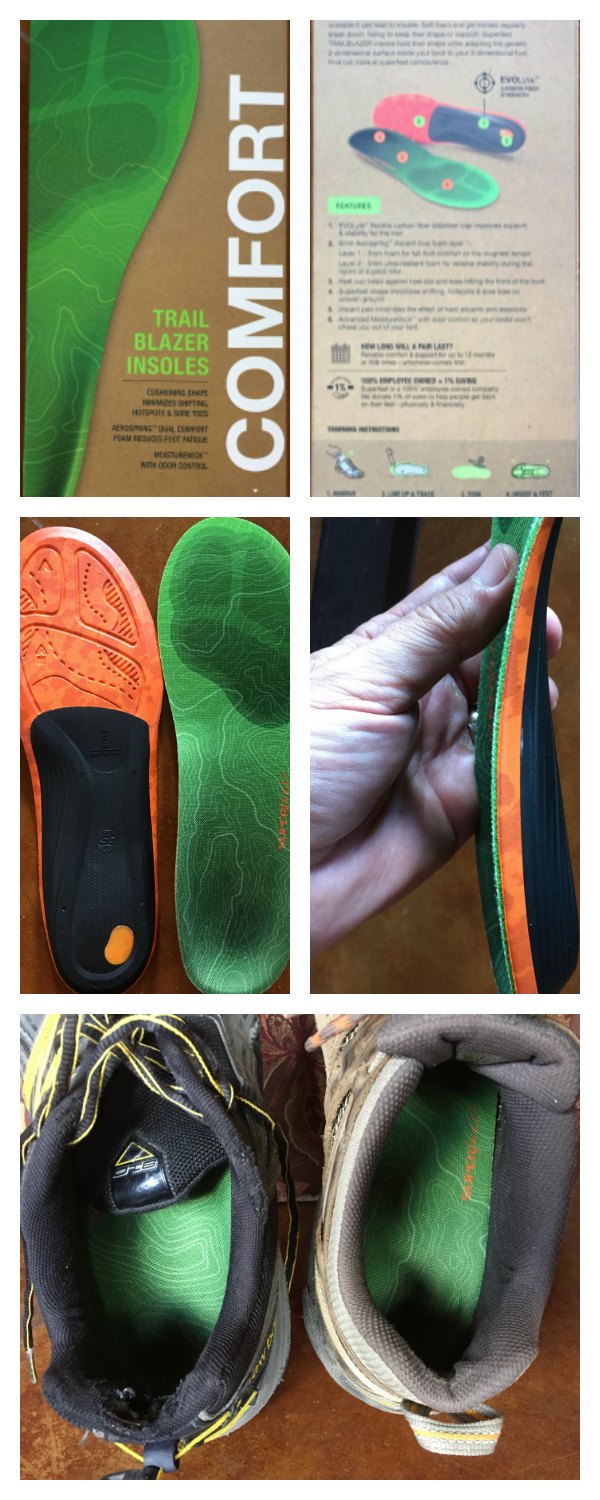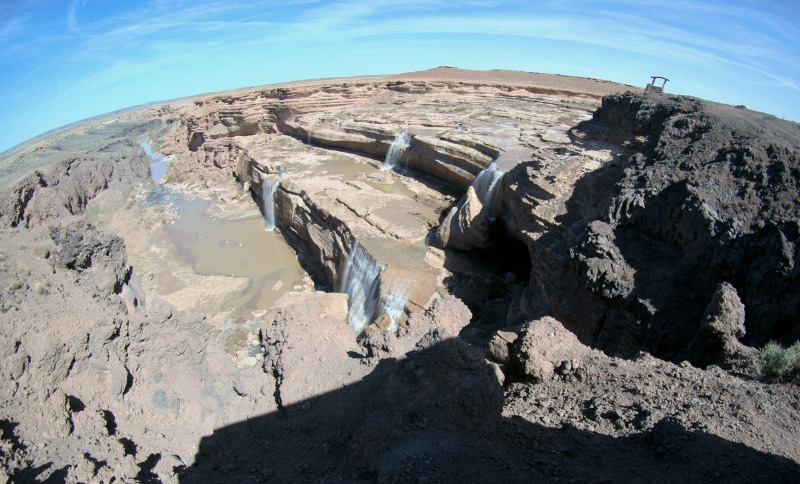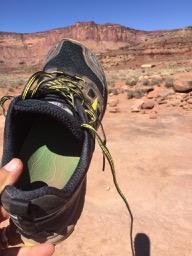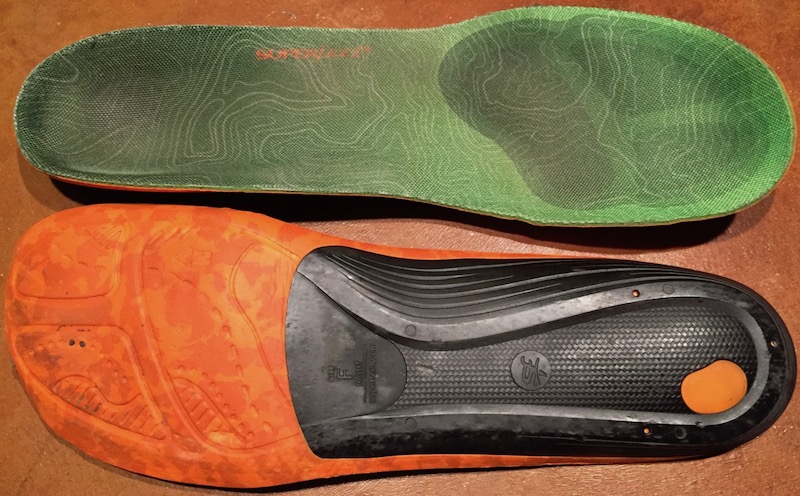

 |
 |
 |
Guest - Not logged in | |||||||||||||||||||||||||||||||||||||||||||||||||||||||||||||||||||||||||||||||||
Reviews > Footwear > Footbeds and Insoles > Superfeet TrailBlazer Insoles > Test Report by Kurt PapkeSuperfeet Trail Blazer Insoles
| ||||||||||||||||||||||||||||||||||||||||||||||||||||||||||||||||||||||||||||||||||
| Name: | Kurt Papke |
| Age: | 63 |
| Gender: | Male |
| Height: | 6' 4" (193 cm) |
| Weight: | 220 lbs (100 kg) |
| Email address: | kwpapke at gmail dot com |
| City, State, Country: | Tucson, Arizona USA |
The Superfeet Trail Blazer Insoles (hereafter referred to as "the
insoles") are meant to replace shoe manufacturer-provided insoles.
They are designed specifically for hikers. They come in
different sizes, but may need to be trimmed by the consumer for
exact fit.
I have a size 12 foot (46 EU), but I typically wear a size 13 (47
EU) shoe to avoid problems with black toenails. Based on
that shoe size, I requested an 11.5-13 (45.5-47 EU) sized insole.
| Manufacturer: | Superfeet Worldwide,
Inc. |
| Manufacturer website: | https://www.superfeet.com/ |
| Model: |
Trailblazer Comfort
Max |
| Year of manufacture: | 2017 |
| Country of origin: |
Not listed |
| MSRP: |
$49.95 USD |
| Color tested: |
Only available in green/orange |
| Size (mens): |
Tested: 11.5-13 (
45.5-47 EU) Also available in 9.5-11, 7.5-9, 5.5-7, 2.5-4 (kids) Available sizes (EU): 43.5-45, 40-43, 37.5-39, 33-35.5 (kids) |
| Weight: |
Listed: Not listed Measured: 4.62 oz (131 g) |
| Dimensions: |
Listed: Not listed (size dependent) Measured: 12.2x4.13x1.02 in (31x10.5x2.6 cm) |
| Warranty: |
60 days |
 The
upper left and upper right photos show the shelf packaging, which is
made from recyclable cardboard.
The
upper left and upper right photos show the shelf packaging, which is
made from recyclable cardboard.I slipped them into two pairs of shoes that I will likely use
them in for most of the testing period, as shown in the bottom
photo at left. The shoe on the left is a New Balance trail
runner, and that on the right is a Keen lightweight hiking
shoe. Both shoes are size 13 (47 EU), and since that matches
the maximum size of the insoles I didn't have to do any trimming
to get them to fit.
I walked around the house a bit and they felt nice and
comfortable. My feet felt very well-supported.
| Date |
Location |
Trail |
Distance |
Altitude |
Weather |
Shoes and Socks used |
| March 31-April 2 |
Saguaro National Park East near Tucson,
Arizona |
Miller Cr,
Heartbreak Ridge, Turkey Cr |
22 mi (35.4 km) |
4240-8400 ft (1300-2560 m) |
25-60 F (-4-16 C) Sun, snow showers, high winds |
New Balance Trail Runners and Injinji socks |
| April 14-16 | Area surrounding Flagstaff, Arizona | Grand
Falls, Devil's Bridge |
5 mi (8 km) | 4300-8000 ft (1310-2440 m) |
32-75 F (0-24 C) |
New Altra Lone Peak 3.0 shoes with cotton
low-rise socks. |
| May 4-7 | Chiricahua Mountains, Arizona | Morse and
Echo Canyons |
10 mi (16 km) | 6600-8200 ft (2010-2500 m) |
48-80 F (9-27 C) Mostly sunny, wind gusts to 30 mph (48 kph) |
Altra Lone Peak 3.0 shoes and Injinji sock |
| May 25-30 | Monument Valley and Canyonlands NP in SE Utah | Canyonlands |
5 mi (8 km) |
3900-6200 ft (1190-1890 m) |
Sunny, very windy with blowing dust, temperatures 50-85 F (10-29 C) | Altra Lone Peak 3.0 shoes and cotton crew
socks |
| July 29-August 6 |
San Juan mountains
between Durango and Silverton, Colorado |
Various |
45 mi (72 km) total across 7 hikes | 8000-12,500 ft (2440-3810 m) |
38-75 F (3-24 C) Sun, rain showers, high winds |
Altra Lone Peak 3.0 shoes and Injinji sock |
Three-day backpack into the Rincon Mountains that make up the
Saguaro National Park East Unit. This is a great hike as it
is one of the few substantial loop hikes in the area, with only a
short road walk between the two trailheads to complete the
loop. This is great terrain to test out insoles, as the
treadway was a mix of rocks, gravel and small stones. There
were even short stretches of cushy walks through pine needle
covered forests.
My feet felt great on this trip - no blisters, no sore
feet. I really appreciated the protection provided to the
back half of my feet by the carbon fiber heel cup when ambling
over fields of sharp rocks - I was well-protected. This was
a very successful first outing for the insoles.
This was a 2-night car camping and day hiking trip to a
little-visited waterfall, and a highly-visited arch near Sedona,
Arizona. Before departure I replaced the insoles of my
brand-new Altra Lone Peak 3.0 trail running shoes. This was
a bit of a challenge, as the toebox of the Lone Peaks are very
wide, but the shoe seemed just slightly shorter than my old New
Balance models. Nonetheless, I was able to insert the
Superfeet insoles without trimming them.

The trails we walked on at Grand Falls (we hiked to the bottom
and back up again) and Devil's Bridge were both very rocky as
shown in the above photo. The Lone Peaks provide quite a bit
of cushioning, but with the Superfeet insoles added to the
protection arsenal I had very happy feet!
This was a car-camping trip to the Chiricahua Mountains of
southeastern Arizona which included two substantial hikes:
The Morse Canyon trail was fairly foot-friendly, but the Echo Canyon trail was quite rocky which made me appreciate the Trail Blazer insoles. I finished both hikes with happy feet.
 This was an epic 6-day tour of Monument Valley,
Valley of the Gods, Gooseneck State Park, and Canyonlands NP White
Rim Trail by Jeep. We took several day hikes during the
week, nothing really long but enough to put my feet through their
paces.
This was an epic 6-day tour of Monument Valley,
Valley of the Gods, Gooseneck State Park, and Canyonlands NP White
Rim Trail by Jeep. We took several day hikes during the
week, nothing really long but enough to put my feet through their
paces.
I took the picture at left of the insoles in-place just before putting my shoes on. Our hike was the big wall in the background, though we came just short of summiting it due to time and temperature (too hot!)
The insoles performed just excellent in the rocky terrain of the
Moab area. My feet were comfortable and sustained no
injuries or pain of any kind.
The red rocks of the Moab area in Utah stain everything,
including the insoles where the dirt just gets ground into the
fabric. Time to throw them in the laundry! They
cleaned up very well and came out looking like new.
This was a week-long car camping trip which included hikes every day we were not driving to/from Tucson Arizona. The trails we explored varied greatly in their foot-friendliness - some stretches were mossy and soft, others were rocky with poor footing. After a week of daily hiking my feet were in surprisingly good shape with no soreness or pain. This is a very positive outcome! Here's what they looked like at the conclusion of this four month test, without any cleaning after I returned from Colorado:

I have a sordid history of Plant Fasciitis, and I was pleased
that I had no flare-ups while hiking with the Trail Blazer
insoles. I found them to be very comfortable, and I was very
pleased to see that they held up so well. I liked the way
they gripped my socks - my feet never slid around, and I had no
blisters whatsoever during the test period.
I intend to keep using the Superfeet Trail Blazer insoles on all
hikes where I use boots or trail runners, i.e. footwear that can
accommodate insoles.